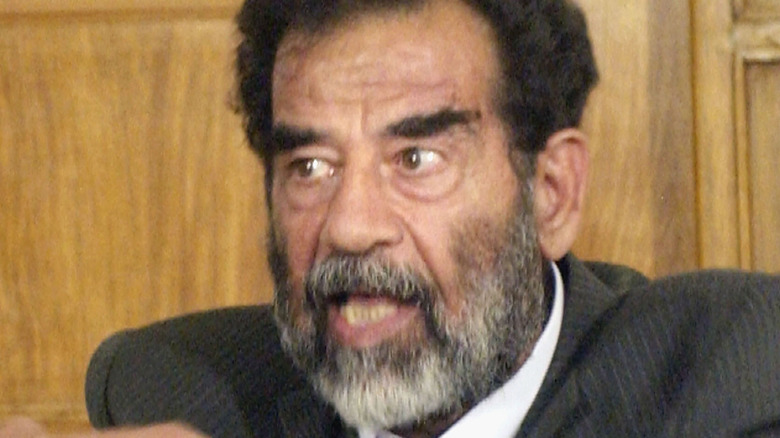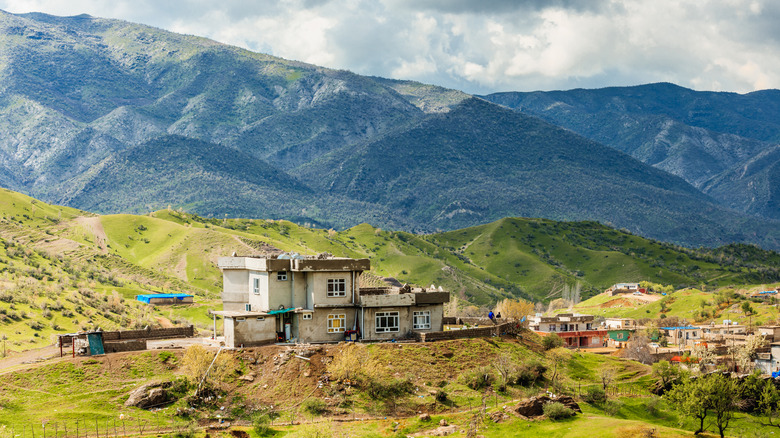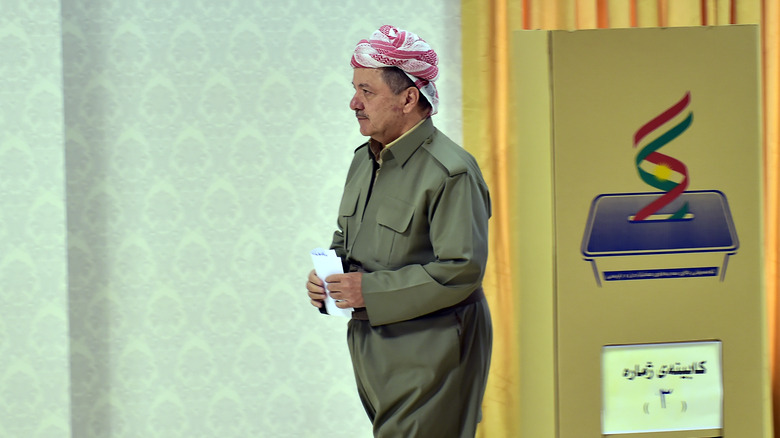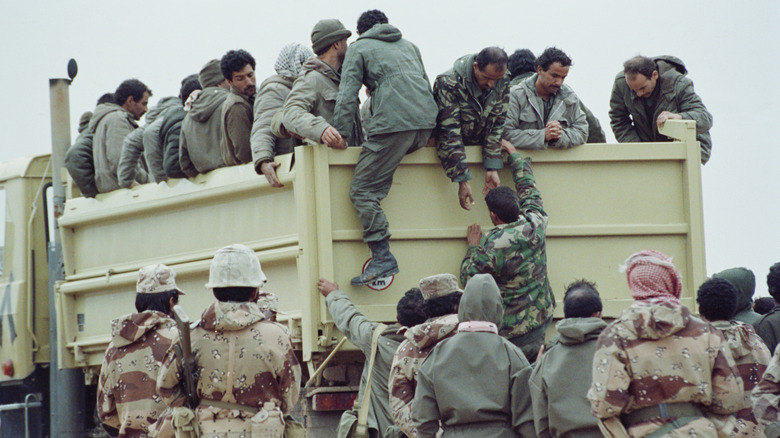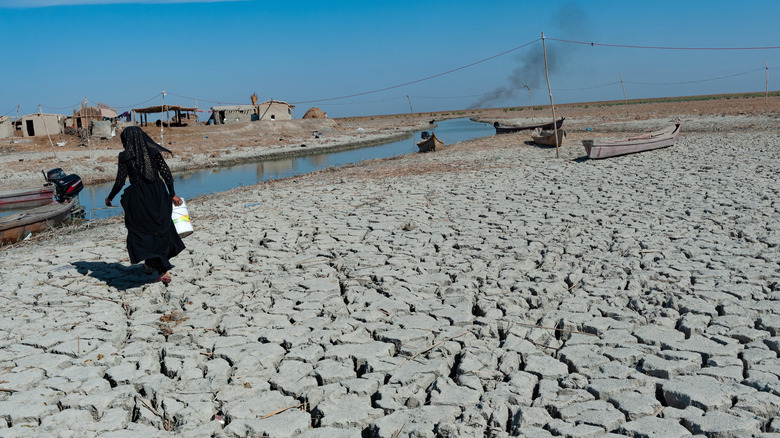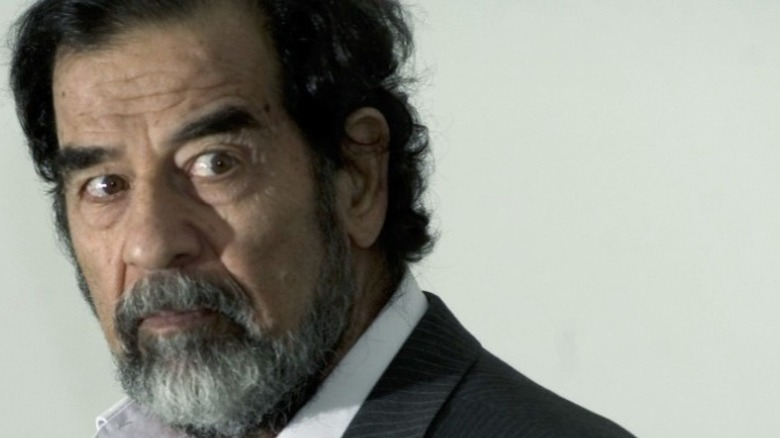How Saddam Hussein Was Even More Evil Than You Think
For those who might remember the news reporting on the capture, trial, and execution of former Iraqi dictator Saddam Hussein, the details involving his brutality seemed to focus on two sets of events. The CNN reported invasion of Kuwait in August of 1990 by Hussein's troops is still burned into the minds of many Gen Xers, and the description of how he ordered chemical weapons attacks against the Kurds shook us all to our core.
Without a doubt, those two decisions by Hussein were enough to bring him to trial for crimes against humanity, including murder and torture (via Fox News). Factor in these events with the fact that Hussein also drove Iraq to financial ruin following an unnecessary war against neighboring Iran from 1980 to 1988 (via Britannica), and you have the perfect outline for what not to do if you have unbridled control over a people. Unfortunately, Hussein had a long history of seizing and maintaining power through extreme violence. Hussein's resume of terror included imprisoning and murdering suspected political opponents, razing entire villages where he suspected adversaries lurked, and destroying the very lands upon which his own subjects made their livelihoods (via ABC News).
While his hanging on December 30, 2006, officially put an end to his grip on Iraq, it didn't even begin to rectify the countless acts of horror he committed against his own countrymen and women.
Fayli deportations
Saddam Hussein's first moves toward genocide involved a sub-sect of Shi'a Muslims known as the Fayli. This group inhabited small villages in the Zagros mountain range, which sits on the border between Iraq and Iran (via PBS). Hussein's political party, the Ba'athists, regarded the Fayli people as Iranians. As Hussein was beginning to wage an eight-year-long war with Iran, he set out to systemically eliminate anyone he considered Iranian (or allies of the Iranians) within his own borders (via ABC News). The Fayli were the first such group Hussein attempted to "cleanse."
Hussein sent security forces into the Fayli villages and conducted house-to-house raids. The Fayli people were forced to leave in military trucks, where they were later unloaded at nearby military bases. Once there, men of fighting age were separated and trucked away, never to be seen again. Many of the women were imprisoned and subjected to rape and torture.
After being held captive, the women and children were sent on a forced march across the border into Iran. This journey was an arduous one, whose obstacles included land mines, harsh elements, and exposure to the crossfire between the warring Iranians and Iraqis. Many did not survive the trek across the border. The U.S. State Department estimates that the Fayli deportation resulted in the deaths of thousands of the Fayli sect (via PBS). But Hussein wasn't finished with his barbarism. In fact, he was just getting started.
Barzani abductions
In 1983, Saddam Hussein began to focus on the Kurdistan Democratic Party, or the KDP. The KDP publicly announced its support for Iran in the Iran-Iraq War, infuriating Hussein. Based out of the northernmost region of Iraq, the KDP and the majority of the Kurds were under the leadership of Massoud Barzani, an avowed anti-Ba'athist (via CNN).
To retaliate against the KDP, Hussein sent Iraqi government forces to Kurdish villages. There, they rounded up over five thousand males, some as young as ten years old (via ABC News). These villagers were taken by the Iraqi military and never seen alive again. It was presumed that all of them were murdered under Hussein's orders. In 2005, a mass grave was uncovered, with the bodies of those who were later identified as some of the Kurdish villagers who were kidnapped 22 years prior. All accounted for, there were 512 bodies laid to rest at the site.
To date, the fate of the remaining 4,500 plus Kurds remains officially unknown. A memo uncovered later revealed that Hussein had been directly involved (via ABC).
Dujail reprisal
On a summer day in 1982, Hussein was paying a visit to the small city of Dujail. While on his visit, his caravan of vehicles came under light gunfire from anti-Ba'athists that were from the area (via Thought Company). In what he considered an assassination attempt, Hussein exacted immediate retribution. Not caring if anyone innocent was punished, he ordered 140 "fighting-age men" to be rounded up. These men and boys were shipped out of Dujail and never seen or heard from again.
As if that weren't bad enough, Hussein ordered another 1,500 townspeople into trucks and taken to prisons (via Thought Company). There, the new prisoners were subjected to torture off and on for nearly a year. Those who survived were exiled to a desert encampment, forbidden to return to Dujail (not that returning to Dujail would have been beneficial to these poor people). While they were incarcerated, Hussein ordered the property of the convicted to be destroyed. Businesses were looted and razed, homes were bulldozed, and farmland was totally destroyed.
At this point, Hussein can be blamed for waging a winless war against Iran, destroying a healthy Iraqi economy, gassing his own citizens, and making genocidal moves against groups of people under his leadership. What would he follow all of this up with? Following the end of the Persian Gulf War in 1991, Hussein committed one of his most brutal moves up to that point in his regime.
Creating an environmental crisis
If you had traveled to southern Iraq prior to 1991, you would have found yourself among some 250,000 agrarians known as the "Marsh Arabs" (via Relief Web). Today, there are less than 40,000 of them left due to unspeakable acts by Saddam Hussein in the early 1990s.
The area that the Marsh Arabs had settled generations ago is in the midst of the Fertile Crescent, where the Tigris and Euphrates rivers cross. There, this group raised livestock, farmed, and kept a sustainable way of life. But the way of life that the Marsh Arabs had experienced for thousands of years abruptly ended as the result of yet another punishment for disloyalty that Hussein meted out against Iraqi citizens.
Accusing the Marsh Arabs of disloyalty during the Persian Gulf War, Hussein's military invaded the area and killed thousands of people (via Thought Company). Forty thousand more were ordered exiled into Iran (via Relief Web). Villages were razed, and farmland was destroyed under Hussein's orders.
In an effort to keep any of the fleeing Marsh Arabs from resettling in the area, Hussein ordered a complex system of dams and canals to be built. This diverted river water away from lands that had been forever fertile and livable. Images taken via satellite in late 2002 show that just 7 to 10 percent of the marshlands remained (via Thought Company). In a decade, Hussein destroyed not only a group of people but also the way of life for thousands of Iraqis. Thankfully, his reign was nearly over.
The end of an era of terror
After the fall of Baghdad in April of 2003, Saddam Hussein and his close allies fled the city to safer lands (via History). Able to evade U.S. forces for nearly eight months, Hussein took refuge on a farm property outside the city of Tikrit (via History). But he was on borrowed time. In December of 2003, Hussein was captured on the same property. He was found inside of a 6x9-foot hole in the ground, unkempt and resigned to his fate.
According to BBC News, Hussein was found guilty of the murders of 148 Shia Muslims in Dujail in November 2006 and sentenced to death by hanging. Following the guilty verdict, Hussein immediately requested and was given an appeal to the Iraqi Supreme Court. The high court upheld his conviction and death sentence and ordered that his execution be carried out before the end of 2006. On December 30 of that year, he hung from the gallows.
Though immediately interred in a posh mausoleum, Hussein's surviving family and Sunni allies felt that his resting place would eventually be the target of vandalism and moved his remains to an undisclosed location in 2014. Several months afterward, the mausoleum was destroyed in an attack, leveling it beyond recognition (via South China Morning Post). While his body was no longer there, it was an act of poetic justice for many that Hussein's celebrated final resting place suffered the same fate as the scores of villages that were destroyed under his iron fist.
